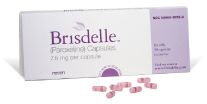Rx Product Profile: Noven Therapeutics' Brisdelle
On June 28, 2013, the FDA announced approval of Brisdelle (paroxetine) 7.5-mg capsules for the treatment of vasomotor symptoms (VMS) associated with menopause, including hot flashes and night sweats.

On June 28, 2013, the FDA announced approval of Brisdelle (paroxetine) 7.5-mg capsules for the treatment of vasomotor symptoms (VMS) associated with menopause, including hot flashes and night sweats. Up to three-fourths of postmenopausal women experience these symptoms. Paroxetine is indicated to treat moderate to severe VMS; however, at this dose, paroxetine is not approved for treatment of any psychiatric condition.1-3
In the United States, higher doses of paroxetine have been used to treat anxiety, obsessive compulsive disorder, depression, and other psychiatric conditions since 1992. Due to prior experience with paroxetine, this lower-dose formulation carries a black-box warning cautioning health care professionals and caregivers to monitor patients taking paroxetine for suicidal thinking and associated behaviors.2
Pharmacology and Pharmacokinetics
Paroxetine is a selective serotonin reuptake inhibitor, but its mechanism of treating VMS remains unknown.2
After a single oral dose of paroxetine, peak concentrations occur within a median of 6 hours, and most patients achieve steady-state medication levels within 12 days of treatment. Due to its partial reliance on a readily saturated enzyme for metabolism—CYP2D6—paroxetine exhibits nonlinear pharmacokinetics and does not have a reliable half-life. However, plasma concentrations may not be indicative of clinical effects because 99% of each paroxetine dose is distributed throughout body tissues, such as the brain. The 1% of medication remaining in blood plasma is >90% protein bound.2
Dosage and Administration
Each 7.5-mg capsule of paroxetine should be taken in the evening, and may be taken with or without food, although studies with higher-dose formulations indicate that food may slightly increase the bioavailability of paroxetine. No dose adjustment is recommended in patients with kidney or liver impairment, but it may be worthwhile to note that patients with liver function impairment or with a creatinine clearance of 30 to 60 mL/min experienced a doubling of total drug exposure and peak plasma concentrations compared with healthy patients.2
Clinical Trials
In a 12-week study, investigators measured the number of daily VMS episodes experienced by each of 606 women. At baseline, investigators found that patients experienced a median of 10.4 episodes daily with reductions to 6.1 daily episodes after 4 weeks of treatment and 4.5 daily episodes after 12 weeks of treatment. These reductions were significantly greater than those observed among patients receiving placebo (P <.01). Investigators also measured reductions in the severity of residual VMS episodes. After 24 weeks, 48% of patients treated with paroxetine experienced a ≥50% reduction in the frequency of VMS episodes versus 36% of patients receiving placebo (number needed to treat ≈ 8).2
Contraindications, Warnings, and Precautions
Contraindications include use with pimozide or thoridazine due to the risk of QT interval prolongation, use with monoamine-oxidase inhibitors due to the risk of serotonin syndrome, use during pregnancy due to a category X designation, and use in patients with a hypersensitivity to paroxetine or its excipients. Paroxetine may reduce levels of tamoxifen or digoxin and may increase levels of atomoxetine, theophylline, warfarin, and tricyclic antidepressants. Medications such as phenobarbital, phenytoin, and fosamprenavir/ritonavir may reduce levels of paroxetine, while cimetidine may increase paroxetine levels. Coadministration of paroxetine with CYP2D6 substrates warrants caution.2
Hyponatremia, bone fractures, cognitive or motor impairment, serotonin syndrome, seizures, mania or hypomania in patients with bipolar disorder, and abnormal bleeding are possible adverse events to monitor for in patients using paroxetine.2
Common adverse events, including headache, fatigue, nausea, and vomiting, occurred in 4.7% of women taking paroxetine versus 3.7% of women taking placebo (number needed to harm ≈ 100). Abdominal pain, attentional disturbances, headache, and suicidal ideation were the most common adverse events associated with discontinuation of treatment, with each adverse event occurring in 0.3% of patients.2
Michael R. Page earned his PharmD from the Ernest Mario School of Pharmacy at Rutgers University. He has worked as a community pharmacist at CVS Pharmacy and is currently clinical editor in clinical and scientific affairs at Pharmacy Times.
References
- FDA. FDA approves the first non-hormonal treatment for hot flashes associated with menopause. www.fda.gov/NewsEvents/Newsroom/PressAnnouncements/ucm359030.htm. Accessed August 30, 2013.
- BRISDELLE (paroxetine) capsules [package insert]. Miami, FL: Noven Therapeutics, LLC; 2013.
- Noven Pharmaceuticals, Inc. Paroxetine mesylate 7.5 mg advisory committee briefing document. www.fda.gov/AdvisoryCommittees/CommitteesMeetingMaterials/Drugs/ReproductiveHealthDrugsAdvisoryCommittee/ucm341586.htm. Accessed August 30, 2013.

